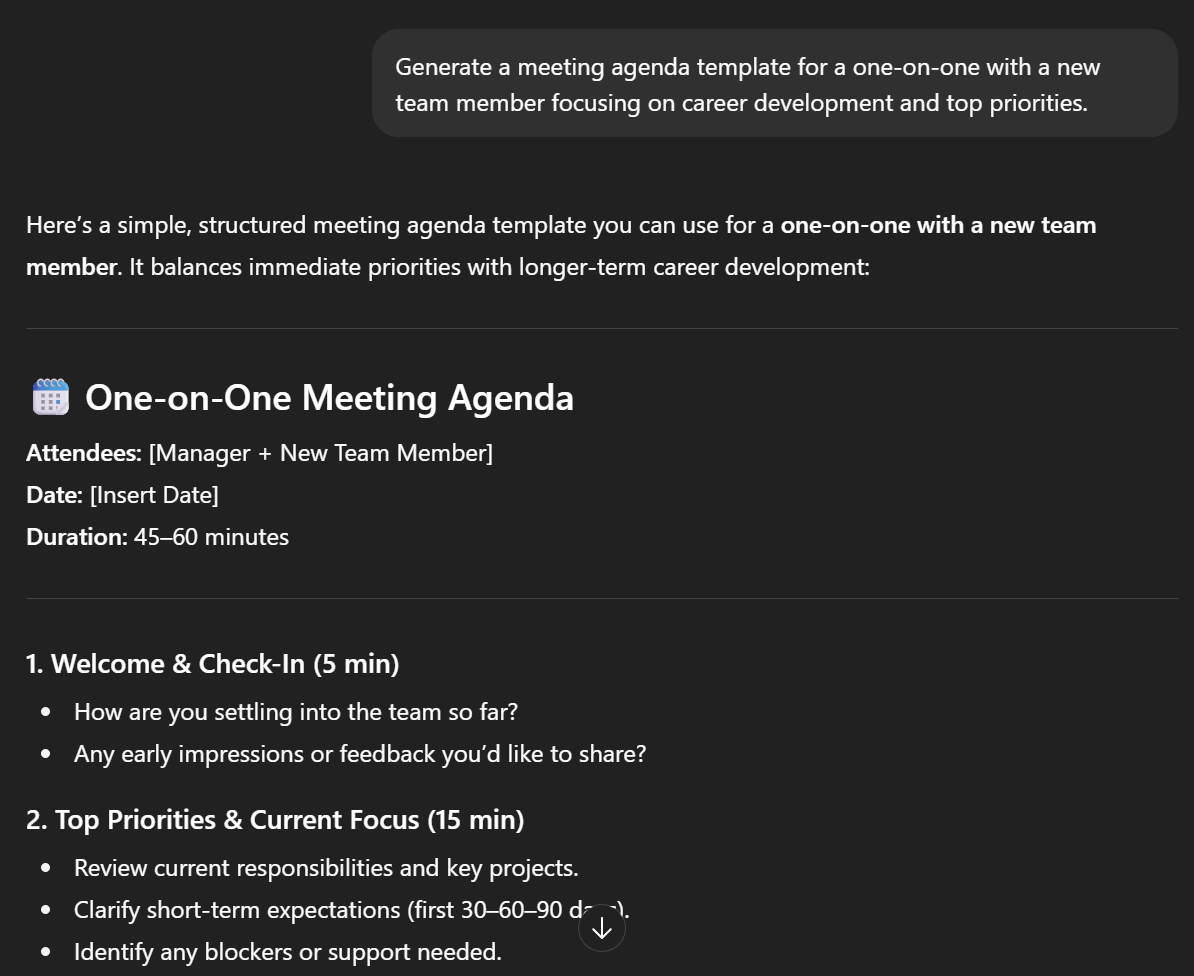Supercharge Your One-on-One Meetings with ChatGPT
July 19, 2023
July 19, 2023
August 29, 2025
August 29, 2025
One-on-one meetings matter. They shape career development, strengthen team culture, and give space for real feedback. But without structure, they can feel like another conversation that goes in circles.
With ChatGPT, you can create a meeting agenda, set clear talking points, and prepare constructive feedback in advance. Later, we’ll look at how another AI tool helps capture insights, track decisions, and keep follow-ups on the same page.
What is a 1:1 Meeting?

A one-on-one meeting is a dedicated time for open conversation between two people. Most often, it’s between a manager and a direct report, but it can also be peer-to-peer. The goal is to exchange feedback, discuss professional goals, and align on priorities.
- These meetings strengthen communication and help with career development.
- They provide space to celebrate wins, review challenges, and set expectations for the next meeting.
- They also improve team culture by giving each team member time to share ideas, raise concerns, or talk through career goals.
One-on-one meetings usually last 30 to 60 minutes. This dedicated time ensures important topics like constructive feedback, status updates, or professional development don’t get lost in day-to-day work.
When I worked as a full-time manager in a startup, I scheduled weekly one-on-ones with each marketing team member. Each meeting lasted 30 minutes, often starting with a quick check-in about their past week.
I didn’t send a meeting agenda beforehand, which made the conversation feel more relaxed. Some employees worry these meetings mean they’re in trouble, so keeping it casual helped them open up.
I usually ask three simple questions:
- How are you doing with your role and workload?
- What are your most recent wins?
- Are there areas in your work, team, or company you’d like to improve?
These talking points helped me see if a direct report was satisfied, what their top priorities were, and where they needed more or less direction. Over time, the meetings became a well-rounded discussion that supported both performance reviews and day-to-day work.
How to Use ChatGPT for 1:1 Meetings
ChatGPT can act like a planning partner for one-on-ones. It helps managers prepare, stay focused, and follow up without spending hours writing notes.
Here are a few ways to use it before, during, and after a one-on-one meeting:
- Prepare a meeting agenda: Ask ChatGPT to create a 1-on-1 meeting template with talking points. Example: “Generate a meeting agenda template for a one-on-one with a new team member focusing on career development and top priorities.”
- Draft constructive feedback: Use it to phrase difficult conversations. Example: “Help me provide constructive feedback to a direct report who needs more or less direction on projects.”
- Role-play tough conversations: ChatGPT can simulate how a direct report might respond when you exchange feedback. This helps you test different approaches.
- Summarize meeting notes: After the call, paste your notes and ask: “Turn these notes into a clear list of action items for the next meeting.”
- Career growth discussions: Use prompts like “Suggest questions I can ask in a one-on-one meeting about a direct report’s career goals and professional development.”
- Use connectors for deeper insights: With the Google Calendar connector, ChatGPT can analyze your past one-on-ones and surface trends across recurring meetings. If you store transcripts in Google Drive (for example, from Tactiq), ChatGPT can perform deep research across all of your one-on-one meetings.
If you want to try it out, start with the free ChatGPT plan before moving to advanced features.
If you want to explore different approaches, you can also try ChatGPT alternatives like Perplexity for inspiration on new meeting styles.
More Sample ChatGPT Prompts for 1:1 Meetings
Here are some ready-to-use prompts you can copy or adapt for your meeting:
- “Create a one-on-one meeting template for a direct report focused on employee engagement and team culture.”
- “Suggest five questions I can ask to learn more about a direct report’s career goals and professional development path.”
- “Draft constructive feedback for a team member who wants more or less direction in their day-to-day work.”
- “Summarize discussion points from the past week into status updates I can share in our team meetings.”
- “Write talking points for an annual review that connects career development goals with team performance.”
Using AI in your 1:1 meetings with ChatGPT can streamline the process and ensure that every meeting is as productive and effective as possible.
However, make sure to always double-check the outputs from ChatGPT. Remember that outputs are not always 100% accurate.
As a manager or leader, you know your company and employees best. Use it as a starting point, but you should have the final decision. Use the advice that makes sense and make sure you’re not going to get in trouble with HR (or legal!).
How Do You Structure a 1:1 Meeting?

Every one-on-one meeting works best with a clear structure. You don’t need to follow a rigid script, but having a simple meeting agenda template ensures you cover important matters for both you and your direct report.
Here’s a one-meeting template you can adapt:
- Preparation: Review notes from the last meeting. Draft a few talking points with a meeting agenda template so you stay on track.
- Check-in: Start with a personal check-in. A quick chat about their past week or personal life helps employees feel valued.
- Progress review: Look back at top priorities, status updates, and goals from the last meeting. Celebrate wins and note any challenges.
- Career development: Discuss the direct report’s career goals and professional development. This is where you connect day-to-day work with long-term career goals.
- Concerns: Provide constructive feedback and invite them to share feedback with you. This open exchange improves team culture.
- Look ahead: Set expectations for the week ahead, the upcoming quarter, or even long-term professional goals.
- Wrap-up: Summarize discussion points, agree on action items, and confirm next meeting details.
Not every conversation needs to cover all of these. Weekly meetings might lean toward status updates and short-term goals, while monthly one-on-ones can focus more on professional development and direct report’s career goals.
Some managers also try asynchronous one-on-ones between calls. For example, you could ask a new team member to share feedback or send their top priorities for the upcoming quarter in a quick message before your next meeting.
The key is consistency. A well-rounded discussion helps employees feel valued, improves team culture, and makes recurring meetings a dedicated time for growth.
💡 Pro Tip: Don’t want to take notes while running through your meeting agenda template? Use Tactiq to capture transcripts in Zoom, Google Meet, or MS Teams and get instant summaries.
How to Enhance 1:1 Meetings with Tactiq

Taking notes in real time can distract from the conversation. The real value comes later, when you need to revisit what was said and track how your direct reports improve over time. That’s where Tactiq helps.
Tactiq works with Zoom, Google Meet, and Microsoft Teams to capture live transcripts of your one-on-one meetings. Instead of juggling notes or struggling to recall discussion points, you get organized outputs you can search, review, and build on in your next meeting.
Here’s how Tactiq can improve your one-on-one meetings:
- Live transcriptions: Follow the conversation in real time without missing key points.
- Custom summaries: Create concise notes you can revisit before the next meeting.
- Follow-up emails: Draft personalized updates for each direct report, covering constructive feedback, career goals, and top priorities.
- Built-in AI prompts: Ask questions directly about the meeting transcript to extract insights, generate action items, or create a new meeting agenda.
- AI workflows: Automate post-meeting tasks in just a few clicks. Extract insights, update your CRM, create tickets, or send summaries to Slack and email. You can also sync with Google Drive or even connect Google Drive to ChatGPT to extend how you use meeting insights.
With Tactiq, you can build your own templates for different types of one-on-ones, like a first meeting with a new team member, monthly one-on-ones for employee development, or even annual review conversations. This way, every meeting stays focused and aligned with long-term goals.
Start turning your meetings into clear next steps. Download the free Tactiq Chrome Extension today and see how transcripts, summaries, and AI workflows can save time and keep you and your direct reports on the same page.
Wrapping Up: Supercharging 1:1 Meetings with AI
One-on-one meetings are more than status updates. They’re a dedicated time to exchange feedback, support career development, and strengthen team culture. With the right tools, these conversations become easier to prepare for, more focused, and more valuable for both managers and direct reports.
ChatGPT helps with talking points, constructive feedback, and meeting agenda templates. Tactiq takes it further by turning live transcripts into summaries, follow-ups, and reusable templates for recurring meetings. Together, they make sure your meetings drive employee engagement and professional development.
Start using Tactiq today and make every meeting count.
FAQs About Supercharging One-on-One Meetings with ChatGPT
How can structuring a one-on-one meeting improve its effectiveness?
Using a meeting agenda template with clear talking points keeps conversations focused, supports career goals, and ensures each meeting ends with actionable next steps.
What are the benefits of using ChatGPT for one-on-ones?
ChatGPT helps you create agendas, draft constructive feedback, role-play tough conversations, and turn meeting notes into clear action items for the next meeting.
How does Tactiq enhance one-on-one meetings?
Tactiq transcribes meetings on Zoom, Google Meet, and MS Teams, then generates summaries, follow-ups, and reusable templates for recurring meetings.
Can I reuse the same meeting template for different direct reports?
Yes. Save your own templates for a first meeting with a new team member, monthly one-on-ones, or annual reviews to track progress over time.
Should I rely only on AI outputs for my meetings?
AI tools provide structure and save time, but managers should always review outputs to make sure feedback, goals, and follow-ups reflect each direct report’s needs.
Structuring your 1:1 meetings with clear preparation, check-ins, progress reviews, and action items ensures focused conversations and actionable outcomes. You leave each meeting with clarity on next steps, making your time more productive and valuable.
ChatGPT helps you prepare agendas, organize meeting notes, draft follow-up emails, and phrase feedback constructively. This saves you time and ensures your meetings are more organized, so you can focus on building stronger relationships and driving results.
Tactiq’s AI Meeting Kit transforms your meeting notes into concise summaries, tracks decisions, and captures creative ideas and requests. You gain actionable insights and never miss important points, making follow-up and project coordination seamless.
Install the Tactiq Chrome Extension, link your video conferencing platform, and conduct your meeting as usual. Afterward, access your transcript, generate an AI summary, and use the AI Meeting Kit to create reusable templates for future meetings.
AI tools provide a strong starting point, but their outputs may not always be fully accurate or context-aware. By reviewing and customizing the results, you ensure your meeting notes and follow-ups truly reflect your team’s needs and avoid potential misunderstandings.
Want the convenience of AI summaries?
Try Tactiq for your upcoming meeting.
Want the convenience of AI summaries?
Try Tactiq for your upcoming meeting.
Want the convenience of AI summaries?
Try Tactiq for your upcoming meeting.









